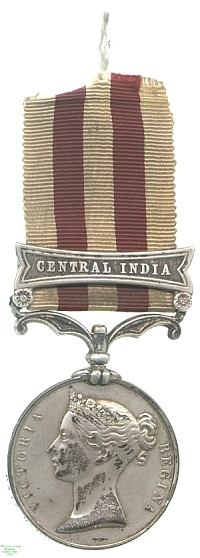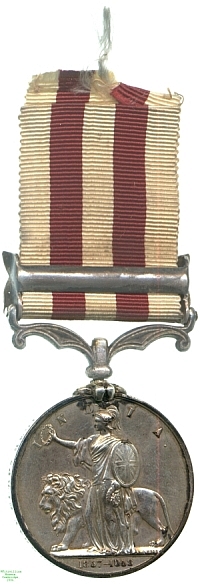
Obverse, a bust of Queen Victoria

Reverse, Britannia before a lion standing facing left, she with a wreath in her right hand

Obverse, a bust of Queen Victoria |

Reverse, Britannia before a lion standing facing left, she with a wreath in her right hand |
The Indian Mutiny of 1857, now regarded in some quarters of India as the First Indian War of Independence, has a history far too complex to be fairly explained here. In briefest summary, resentment at British snubbing of both Hindu and Muslim religious practices among the Sepoy (indigenous) troops of the British East India Company, whose complaints were regarded as mere superstitious nonsense by the European officers of the Company, became the spark that ignited a metaphorical powder keg of Bengali and Northern Indian resentment at the Company's taxation policies, its ever-more-extensive expropriations of Indian landowners' and rulers' territories under threat of arms, and its rearrangement of the Indian economy to suit the Company's entirely commercial interests.
Initial arson attacks and insubordination in early 1857 were followed by whole-unit mutinies and before long coordinated attacks by indigenous soldiery on Europeans in Indian towns. Full-scale war followed, and an initially-slow British resistance, still aided by many Indian troops, entailed perhaps as vicious a set of atrocities against the rebels as they or their civilian cohorts had committed against Europeans. Indian forces were uncoordinated, despite Bahadur Shah Zafur, Emperor of the Mughal rump state around Delhi, being proclaimed Emperor of all India and Sepoy rebels rallying to his standard. British and pro-British forces had secured the country again by mid-1858, and a programme of purges that became known as "the Devil's Wind", including thousands of executions, sometimes of whole village populations, attempted to ensure that the event would not be repeated. Bahadur Shah was exiled to Rangoon, and the East India Company's rule taken over directly by the British Crown.
The British garrison at Lucknow, in the recently-annexed state of Oudh, was warned of the rising in time to fortify the British Residency. Despite a 90-day siege in which the Sepoy opposition brought up artillery and in which the 1700 British or loyalist troops were reduced to 650 fit for battle, the Residency was held, although an initial relief expedition could not lift the siege and had to join the garrison for a further month of siege. Lucknow was finally relieved in October 1857, evacuated and retaken in 1858.
For fighting at Lucknow during the second relief effort and subsequent evacuation, or in the city's recapture the next year, this bar was awarded to the Indian Mutiny Medal. This example was that of Private Jeremiah McCarthy of the 8th Regiment. Lester Watson purchased it at some point before 1928.